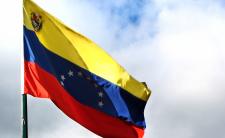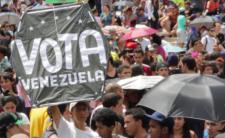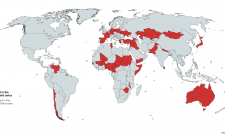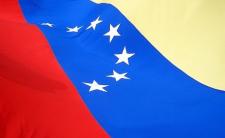Constitutional history
Christopher Columbus first sighted the coast of Venezuela in 1498. About two decades later, the Spanish began to settle in the country. At the time of the settlement, there were as many as 400,000 Amerindians inhabiting the region. This population, however, met with great decline as Spanish colonization brought warfare over valuable resources. During the 16th century, the opening of gold mines in Yaracuy led to the introduction of slavery, at first of indigenous people, and later Africans. It is this history of indigenous settlement, European colonization, and the importation of African slaves that has contributed to modern Venezuela's racial diversity.
The Spanish government ruled Venezuela until the early 1800s, when political discontent began to grow in the colony. In 1810 the revolution to gain independence from Spain began and Venezuela declared its independence a year later on July 5, 1811. This independence, however, was not decisively won until Simón Bolívar's clear victory over the Spanish royalist army in 1821. It was also in 1821 that slavery was abolished and Simón Bolívar successfully integrated the ancient Spanish colonies that were in present-day Venezuela, Colombia, and Ecuador into the Gran Colombia. But this integration was short-lived as Venezuela seceded from the Gran Colombia in 1830.
Venezuela's early history was marked by revolutions, counterrevolutions, and dictatorships. A period of civil war began in 1846 and ended in 1870 when caudillo Antonio Guzmán assumed power. He retained power until his overthrow in 1888. Other notable dictators included Cipriano Castro who ruled between1899 and 1908. Castro caused Venezuela to incur large amounts of debt owed to European countries. When Castro refused to pay the country's outstanding loans, Germany, Great Britain, and Italy blockaded Venezuela's ports. The United States mediated this dispute in Washington D.C. and the dispute finally ended when the Hague Tribunal decided in favor of the European creditors in 1904. In July 1907, Venezuela met its obligations to the three powers. The following year, Juan Vicente Gómez usurped control from Castro, and Gómez remained in power until his death in 1935, with two interruptions (1915-1922; 1929-1931).
Although Gómez was illiterate, he had a keen sense for business. Under his rule, Venezuela developed its agricultural industry and discovered oil, making it one of the wealthiest countries in Latin America. Gómez set up a concessionary system in order to accommodate the foreign companies which flocked to Venezuela in order to lobby for rights of oil exploration and exploitation. By 1927, oil was Venezuela's most valuable export and by 1929 Venezuela was the leading global oil exporter. One of the most widespread critiques of Gómez is that he failed to let Venezuela experience the proportionate benefit from oil production by not imposing adequate taxes on oil companies. His defenders, however, assert that Gómez had to make oil investment attractive in order to encourage the burgeoning industry.
Venezuela continued to be beset by dictatorships during the 20th century. It was not until 1947 that a constitution providing for popular vote by means of secret ballot was promulgated. But despite this promulgation, Venezuela's political system continued to fall prey to violence and corruption. Rómulo Gallegos Freire, a novelist and founder of the Acción Democratíca, was democratically elected as President and then took office in February 1948, but he was overthrown by an army revolt in November of that same year. On November 30, 1952, Col. Marcos Pérez Jiménez was elected President and a new constitution was promulgated in April of 1953. But, in January of 1958 he was forced to flee the country after a general strike in Caracas led to a popular uprising.
It was not until January 1961, with the reelection of President Rómulo Betancourt of the Acción Democrática, that Venezuela began to experience relative tranquility. Rafael Caldera Rodriguez was elected President in 1968 and he successfully stopped guerrilla and terrorist activities. He also pursued a policy of nationalizing foreign enterprises. In December 1973 Carlos Andrés Pérez, leader of the center-left Acción Democratíca, was elected President. He continued the nationalization trend by taking over the iron and steel industry in 1975 and the oil industry in 1976. During the following years, political power shifted away from COPEI leaders such as Luis Herrera Campíns and candidates from Acción Democrática such as Jaime Lusinchi and Andrés Pérez. Venezuela also experienced an economic crisis in the late 1980's that forced it to borrow money from the United States and other countries. Despite this short-term solution, the threats of violent political activity and corruption still loomed. In 1992, Lt. Col. Hugo Chávez attempted a military coup, but was captured and imprisoned.
Recent constitutional building process
Venezuela has a long history of constitutional reforms. In addition to the two constitution-making processes that occurred when Venezuela became independent in 1811 and when it emerged as a separate country from Gran Colombia in 1830, Venezuela has had many other constitution making processes which were carried out in 1858, 1863, 1893, 1901, 1914, 1946, 1953, and 1961. In general, these cases of constitution making processes were consquences of the de facto rejection of the existing constitution through a political coup d' état, a revolution, or a civil war.
However, the most recent reform, in 1999, was distinct. The impetus for it was not a coup, revolution, or civil war: rather, it was the democratic election of Hugo Chávez on December 6, 1998. Chávez had been contemplating constitutional reform since his attempted coup in 1999. One of his 1998 campaign promises was that he would organised a referendum asking the Venezuelan people if they wish to convene a National Constituent Assembly. Chávez said that his goal in leading constitutional reform was to open up political discourse to independent and third parties by changing the national political process and eliminating political corruption of the past.
This appeared as a particularly laudable goal in light of Venezuela's political environment at the time. Venezuelan political historians such as Allan R. Brewer-Carias have described Venezuelan democracy during the second half of the 20th century as lacking true representation and participation. Political parties heavily dominated the political process. At this time, Venezuela used the d'Hondt system, a method of proportional representation based on the party system and pursuant to the 1961 constitution, for the election of party representatives. This system was applied to all national, state, and municipal elections. it was often criticized for creating a situation in which party representatives were more accountable to their parties than to the citizens of the communities that they represented. This led to political corruption. Thus, constitutional reform in order to create a more participatory system may have seemed like a necessary change in 1998 when Chávez promoted the idea. Furthermore, Venezuela's economic downturn during late 1970's and mid-1990's also aroused the call for democratic change. However, the question of how to institute such reform remained.
The legal framework
Chávez's election occurred under the supremacy of the 1961 Venezuelan Constitution. This fact created a serious legal question as to whether the future election of a Constituent Assembly necessitated a constitutional amendment to the 1961 constitution or whether the idea of popular sovereignty could legitimize the election of a Constituent Assembly despite the lack of such authorization in the 1961 Constitution. This question was referred to the Supreme Court. On January 19, 1999, the Supreme Court issued two decisions on the matter. The decisions recognized the possibility of calling a consultative referendum in order to gauge popular opinion regarding an election of a Constituent Assembly while presenting a summary of the constitutional doctrine of constituent power. However, the decisions did not address whether a constitutional amendment was necessary.
Initiating the process
On February 2, 1999, Chávez issued his first decree as President ordering a consultative referendum to ask the Venezuelan people whether a constituent assembly should be convened. The referendum was held on April 25, 1999. 38.7% of eligible voters participated and the referendum received 81.9% yes votes and 18.1% no votes. With this mandate, the work of convening a constituent assembly began.
After the referendum, the work of constitution building continued through the election of the Constituent Assembly. On July 25, 1999 an election was held in order to elect 131 deputies to the Constituent Assembly. One hundred and four deputies were elected from 24 regional constituencies relating to states and federal districts. The number of seats per state or federal district was based on population. Second, 24 deputies were elected in a national constituency and each voter was allowed to choose up to ten deputies for the 24 national representatives. Third, three members were elected to represent the indigenous population. President Chávez's party, Polo Patriotico, won an overwhelming majority of the seats, 94% or 95%. Some argue that this was the result of Chávez's intense campaign work for his party's candidates in which he personally appeared in every state in Venezuela proposing his list of candidates for each constituency. Chávez backed 20 people for the 24 national deputies. and lobbiedfor a list of 10 candidates for eastern states and another 10 candidates for the western states. Ultimately, only 4 of the 24 national deputies were independent candidates opposed to President Chávez.
In August of 1999, the newly elected Constituent Assembly created a Commission of Judicial Emergency aimed at intervening in judicial matters. Furthermore, the Constituent Assembly's other immediate actions consisted of dissolving both the Senate, the Chamber of Representatives of the National Congress, the legislative Assemblies of the States, and suspending municipal elections. These actions provoked public outrage and were challenged in the Supreme Court. In October of 1999, the Supreme Court upheld the Constituent Assembly's actions by recognizing the Constituent Assembly as a “supra constitutional power”. Later, the Constituent Assembly would use its “supra constitutional power” to suspend judges and replace the Court.
Drafting the new constitution
In September of 1999, the Constituent Assembly began the work of drafting the constitution. Various draft proposals were submitted to the Constituent Assembly. The President submitted a document that was prepared with the help of a Constitutional Council composed of independent political leaders. Additionally, a small left-wing party and a non-governmental organization named Primero Justicia submitted drafts.
The Constituent Assembly appointed 20 commissions to determine the standard issues that must be addressed in any constitution and by the end of September; the 20 commissions had sent their drafts to the Constitutional Commission that was in charge of integrating the various commissions' drafts. The Board of Directors of the Constituent Assembly gave the Constitutional Commission only two weeks to integrate almost 800 articles. This short time frame left little room for public discussion and civil society participation. The Constituent Assembly worked to create a coherent and integrated draft of the Constitution in order to submit the Constitution to a referendum by December 1999.
Approving the new Constitution
On December 15, 1999, 44.3% of eligible voters casted their vote for the new Constitution and 71.8% of voters approved it. The National Election Council audited the vote. The new constitution therefore replaced the 1961 Constitution, becoming Venezuela's 26th Constitution and the first constitution in the history of Venezuela to be approved by popular referendum. The 1999 Venezuelan Constitution had 350 articles, making it one of the longest, most complicated, and most comprehensive constitutions in the world.
Major changes
The 1999 Constitution made several changes to the prior constitution. It officially changed the name of the country from the Republic of Venezuela to the Bolivarian Republic of Venezuela.
Many of the changes made related to the structure of government. The 1999 Constitution converted Venezuela's three-branch system of government (executive, legislative, and judicial) to a five-branch system. These five branches are the executive branch which consists of the president, the legislative branch, which consists of the National Assembly, the judicial branch, which consists of the courts, the electoral branch, which consists of the National Electoral Council, and the citizen's branch, which is composed of the Defender of the People, Chief Public Prosecutor, and the Comptroller General, who are responsible for defending citizensstate. The new Constitution also changed the legislative branch from bicameral to unicameral.
Other changes were related to the rights of the Venezuelan people. The 1999 Constitution incorporated the idea of popular sovereignty (such as frequent referendums), social responsibilities, the right to rebel against injustice, and the eternal independence of the republic from foreign domination. Further, it enshrined certain human rights such as free education up to the tertiary level, free health care, access to a clean environment, and the rights for minorities (including indigenous people), to uphold their own cultures, religions, and languages.
in addition, the Constitution reformed the presidency, making Venezuela's presidency stronger than that of most Latin American countries. The 1999 constitution increased the presidential term from five to six years, with each president being entitled to a maximum of two terms. It gave the president the power to dissolve the National Assembly under certain conditions. The Constitution also established a presidential recall referendum in which the people were given the right to remove the president from office before the expiration of the presidential term. Such referenda were automatically were called upon provision of petitions with a valid number of signatures. This new provision was activated for the first time when such a referendum was held in 2004. However, the referendum failed to receive majority support. Constitutional reform in 2009 further strengthened the presidency in Venezuela as 54% of Venezuelan voters backed a constitutional amendment that abolished term limits for elected officials, including the President.
Timeline
| 1498 |
Christopher Columbus sights the coast of what is now Venezuela |
| 1522 |
The Spanish begin settling the coast of what is now Venezuela |
| July 5 1811 |
The General Captaincy of Venezuela declares independence from Spain and creates the Confederation of States of Venezuela |
| 1821 |
Simón Bolívar integrates the Spanish colonies in the areas that are now Ecuador, Colombia, and Venezuela in order to form Gran Colombia |
| 1830 |
Venezuela secedes from Gran Colombia |
| 1846-1870 |
Civil wars consume Venezuela until Antonio Guzmán Blanco assumes power in 1870 and remains in power until he is overthrown in 1888 |
| 1899 |
Cipriano Castro cancels Venezuela's debts to European powers. |
| 1902 |
Great Britain, France, Germany, and other powers block Venezuela's ports in retaliation to President Castro's actions |
| 1903 |
Debt negotiations between Venezuela and various European powers are concluded with a request to the Hague Tribunal for a decision |
| 1904 |
The Hague Tribunal decides in favor of the European creditors |
| 1907 |
Venezuela meets all of its debt obligations |
| 1908 |
Juan Vicente Gómez seizes power from Cipriano Castro and rules as a dictator until his death in 1935. Gómez is credited with transforming Venezuela into a leading exporter of petroleum. |
| 1945 |
Dr. Rómulo Betancourt assumes control as a provisional president after the overthrow of General Isaías Medina Angarita |
| 1947 |
A new constitution guarantees popular vote by means of secret ballot. Rómulo Gallegos Freire, founder of the Acción Democratíca, is elected President |
| 1952 |
Elections are held and Col. Marcos Pérez Jimenez is declared the winner. All opposition leaders are forced to flee the country |
| 1953 |
A new constitution is established and the country's name is changed from the United States of Venezuela to the Republic of Venezuela |
| 1958 |
A general strike in Venezuela causes Jimenez to flee the country. Rómulo Betancourt is elected President |
| 1961 |
Betancourt establishes a new constitution that guarantees rights to labor and establishes the d'Hondt electoral system |
| 1973 |
Carlos Andrés Pérez is elected President |
| 1978 |
President Andrés Pérez nationalizes the oil industry. Later that year, Luis Herrera Campins wins the presidency |
| 1988 |
Andrés Pérez is elected a second time |
| 1989 |
Venezuela experiences an economic crisis and receives emergency loans from the United States and other countries |
| 1992 |
Lt. Col. Hugo Chávez fails in his coup attempt and is captured and imprisoned |
| 1998 |
Hugo Chávez is elected President with a campaign promise of constitutional reform |
| April 1999 |
Chávez calls for a consultative referendum in which the Venezuelan people are asked whether they would like to elect a Constituent Assembly according to the President's terms and the najority vote for the motion |
| July 25, 1999 |
Elections for a Constituent Assembly are held and 131 deputies to the Constituent Assembly are elected |
| August 1999 |
The new Constituent Assembly dissolves the Senate and Chamber of Representatives of the National Congress, dissolves the Legislative Assemblies of the State, and suspends municipal elections |
| September 1999 |
The new Constituent Assembly vigorously engages in the constitutional drafting process |
| October 1999 |
Venezuela's Supreme Court upholds the constitutionality of the Constituent Assembly's actions by conceiving as the Constituent Assembly as a “supra constitutional power” |
| July 2000 |
National, regional, and local elections are held under the 1999 constitution. Chávez is reelected to a six-year term and his party and allies win a majority of the seats of the National Assembly |
| Branch | Hierarchy | Powers | Removal |
|---|






Share this article